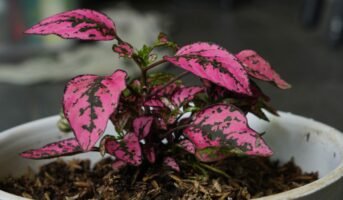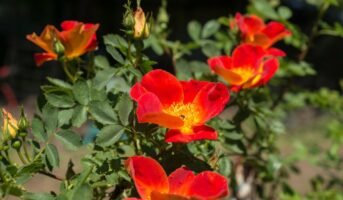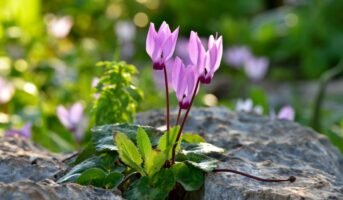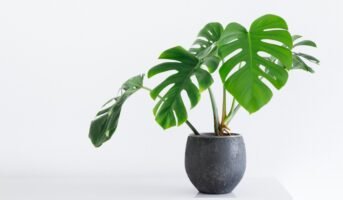Rhapis Excelsa is a small type of palm, also called the lady palm or bamboo palm. It forms dense bunches of thin, erect green stems. This palm is a much-liked indoor houseplant because of how well it tolerates low light levels. Rhapis Excelsa grows less than a foot taller each year, which is a pretty sluggish rate of development.
The palm family includes this elegant-looking palm, which grows in bunches of woody, erect stems. A bamboo-like appearance is created when the lower leaves fall off, leaving scars on the stems. Read on to learn more about Rhapis Excelsa and the best way to grow and maintain it in your garden.

Source: Pinterest
What is Rhapis Excelsa?
Rhapis Excelsa is a small palm species that adapts to a variety of environments, climates, and soils. With multiple uses and benefits, it is one of the most popular houseplants. Present in both tropical and subtropical landscapes, it has a large variety of common names including slender lady palm, bamboo palm, fan palm, Chamaedorea reed palm, finger palm, and parlor palm.
Rhapis Excelsa: Basic facts
| Botanical name: Rhapis Excelsa |
| Type: A small shrub |
| Flower: No |
| Also known as: Lady palm, bamboo palm |
| Height: 3-5m tall |
| Season: Summer |
| Sun exposure: Keep in the shade with a few hours of direct sunlight |
| Ideal temperature: 70 to 90 degrees Fahrenheit |
| Soil type: Well-drained |
| Soil pH: Slightly acidic to slightly alkaline |
| Basic requirements: Intermittent watering, indirect sunlight, home-made fertiliser |
| Ideal location for placement: Outdoors |
| Ideal season to grow: Summer |
| Maintenance: Low |
Rhapis Excelsa: Varieties
- There is a variety of Rhapis Excelsa called ‘Koban’ that displays broad leaf segments and tends to grow outwards.
- In the Rhapis Excelsa ‘Daruma’ variety, the leaves are narrow, and the growth habit is upright. In this fast-growing variety of Rhapis Excelsa, the leaves curl a bit.
- There is a miniature variety of Rhapis Excelsa called ‘Kodaruma’ that has a very slow growth rate.
- There is a variety of Rhapis Excelsa known as ‘Zuikonishiki’ that has green and white stripes on its leaves.
Rhapis Excelsa: How to grow?
Here’s all you need to know about growing Rhapis Excelsa.
Propagation of Rhapis Excelsa
- Rhapis Excelsa seeds need to be kept at 27 degrees Celsius or slightly warmer to germinate successfully.
- A seed-starting tray should be filled with soilless potting medium.
- Sprinkle seeds on the soil and place them on a heating mat or in a warm room.
- Keep the medium moist but not wet with a spray bottle.
- When the medium is well wrung out, it should feel like a sponge.
- It shouldn’t take more than three weeks for seedlings to appear.
- It will not take long for them to form several miniature Rhapis Excelsa plants, so you can transplant them once they are several inches tall.
Growing tips for Rhapis Excelsa
- Water the Rhapis Excelsa plant regularly once it starts blooming if you want it to look its finest.
- Make sure the soil is just moist but not soggy, like a sponge you’ve squeezed out really well.
- It is very critical that Rhapis Excelsa plants receive bright, indirect light for several hours throughout the day, although they can survive in deep shade. This palm, however, cannot tolerate direct sunlight.
- If you’re in the middle of the summer, feel free to place Rhapis Excelsa on your patio, but keep it shaded from direct sunlight.
Rhapis Excelsa growth
The growth of Lady Palms is quite slow. When growing in subtropical temperatures and in 80% shade, Rhapis Excelsa grows at a slow rate, at 8 to 12 inches annually. When grown indoors, the rate of growth is a little bit slower. These plants can reach a height of up to 14 feet and palm fronds between 6 and 12 inches across.
How to care for Rhapis Excelsa?
Lady Palms make excellent indoor plants and will easily fit in a windowless corner of a room. Their upkeep isn’t too difficult, but you will need to develop a regular feeding and watering schedule. Plan to water and feed more frequently throughout the warmer seasons of the year and a little less frequently during the winter.
The interior conditions that your Rhapis Excelsa should flourish in should be comfortable for you as well, aside from that. Aside from that, keep the following care tips in mind.
- It is good for lady palms to be planted outdoors in a dappled shade or even a slightly shady area since they prefer to grow in dappled light. The unfiltered sun causes leaf burn on Rhapis Excelsa if they are placed in direct sunlight.
- It is best to plant Rhapis Excelsa in loamy soil with excellent drainage. The best potting mix for these palms is one made specifically for them.
- In their established state, Rhapis Excelsa plants have average water requirements and are somewhat drought tolerant. During the fall and winter, reduce watering until the top 2 inches of soil feel dry.
- Furthermore, Rhapis Excelsa plants thrive at temperatures between 16 and 27 degrees Celsius, which makes them ideal for indoor cultivation due to their compact size and light needs.
- Fertilisation is only necessary during the growing season for Rhapis Excelsa. If your palm is in bloom, feed it monthly with liquid houseplant fertiliser diluted to half strength between April and September.
Rhapis Excelsa: How to prune Lady Palms?
There isn’t much trimming required for these palms. Rhapis Excelsa may still utilise the nutrients from fronds that have just a little browning, which is a pretty typical occurrence on Lady Palms and generally results from insufficient water or light. On the other hand, you can prune off an entire frond if it is dead or discoloured.

Source: Pinterest
Rhapis Excelsa: Pests and diseases
In general, Rhapis Excelsa don’t have any significant insect or disease issues. However, keep an eye out for spiders and scale mites, which may harm many houseplants. Wilting or yellowing leaves, a sticky substance or webbing on the foliage, and small light or dark spots along the plant are all indications of an infestation. Use a suitable pesticide as soon as possible to treat your Lady Palm.
Rhapis Excelsa: Uses
Rhapis Excelsa can successfully eliminate airborne contaminants, including ammonia, formaldehyde, xylene, and carbon dioxide, from homes. Rhapis Excelsa truly purifies and improves the quality of the air in your house, in contrast to other plants that only produce oxygen.
Rhapis Excelsa: Toxicity
Rhapis Excelsa is not at all toxic to either humans or animals. It’s completely safe to plant Lady Palms in your garden or home without having to worry about any harm coming to your pets or kids.
FAQs
Where did Rhapis Excelsa originate?
Rhapis Excelsa originated in China.
Is Rhapis Excelsa toxic?
No, Rhapis Excelsa is not toxic.
Is Rhapis Excelsa expensive?
Yes, Rhapis Excelsa is quite expensive. They are undoubtedly an elite plant.
Housing News Desk is the news desk of leading online real estate portal, Housing.com. Housing News Desk focuses on a variety of topics such as real estate laws, taxes, current news, property trends, home loans, rentals, décor, green homes, home improvement, etc. The main objective of the news desk, is to cover the real estate sector from the perspective of providing information that is useful to the end-user.
Facebook: https://www.facebook.com/housing.com/
Twitter: https://twitter.com/Housing
Email: [email protected]











